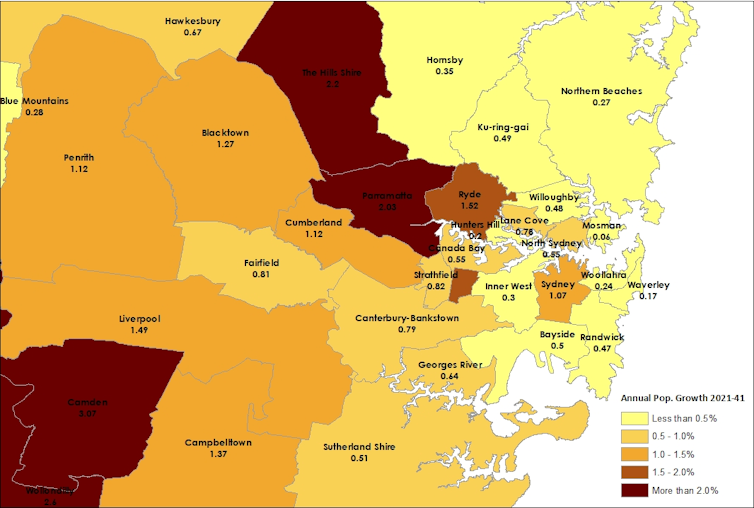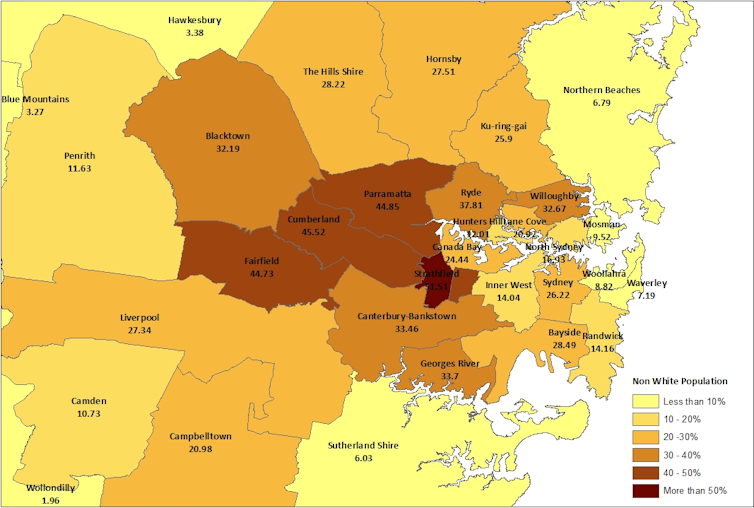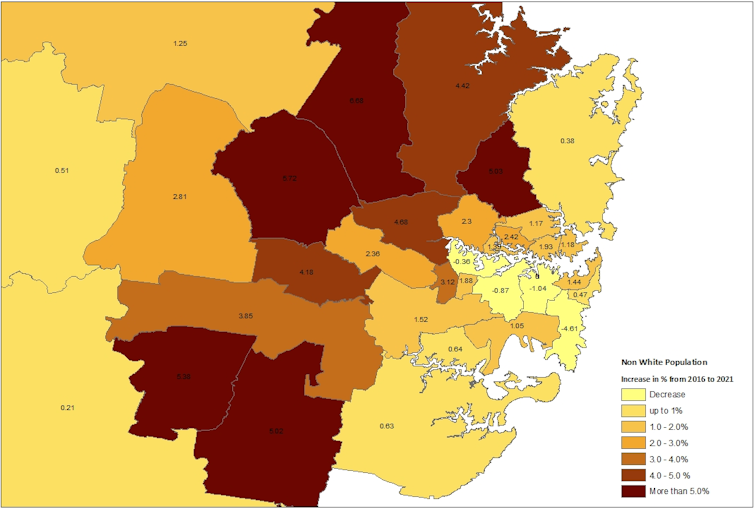
Residents of the affluent east and north of Greater Sydney have strongly resisted housing development in their suburbs. This NIMBY (Not In My Back Yard) resistance has led to urban sprawl in areas of Western Sydney with a well-documented lack of services, infrastructure and jobs.
Recent research showed affluent Sydney communities closer to the city centre are highly influential and organised in resisting development in their neighbourhoods. The result has been a socioeconomically divided city.
Ethnic segregation is a less-talked-about aspect of this divide. Most population growth in Sydney is from non-white new migrants. Dumping them all in the city’s west, when many are suited for and employed in professional jobs, is not only economically unproductive, it also leads to an ethnically segregated city.
Read more: Jobs deficit drives army of daily commuters out of Western Sydney
The ethnic divide is growing
A recent NSW Productivity Commission report shows less than 20% of new dwellings were built within 10 kilometres of the CBD between 2016 and 2021. Unmet demand is greatest in the inner city. As the chart below shows, most residential development has been in the outer suburbs, 30-40km from the city centre.

NSW Department of Planning and Environment population projections for 2021-2041 suggest the vast majority of population growth is going to be in these outer areas. The projections are based on analysis of historical trends, announced policies and local intelligence.
The map below shows inner local council areas will grow much more slowly than the outer ones. These outer areas also have much higher base populations, so their additional people and residential development are going to be large in absolute numbers.

Inner-city councils areas, such as Mosman (0.06%), Inner West (0.3%), Woollahra (0.24%) and Waverly (0.17%), are forecast to grow by much less than 1% a year. Most outer council areas are forecast to grow by at least 1-2%.
Inner-city areas also have a much higher percentage of white residents. The map below, constructed using 2021 census data for place of birth, shows this disparity.

While place of birth is not a perfect indicator of ethnicity, it is commonly used for and serves the purposes of this sort of analysis. The map clearly shows the outer areas of Sydney have a higher proportion of non-white residents. The wealthier inner areas have a much higher concentration of white residents.
These inner areas also tend to have a higher level of NIMBYism and lower population growth projections.
As the map below shows, the concentration of the non-white population in outer areas is also increasing at a much faster rate.

Read more: Another tale of two cities: access to jobs divides Sydney along the 'latte line'
And the trend is set to continue
The national 2022 Population Statement shows Australia’s net overseas migration is estimated to be 235,000 per year until 2032-33. That’s about two-thirds of the nation’s total population growth. The report forecasts about 27% (64,000 a year) of the international migrants will settle in Greater Sydney.
Natural population increase (births minus deaths) for Greater Sydney is estimated to be around 36,000 a year. The net effect of internal migration adds up to around 33,000 people leaving Sydney. So most of the city’s population growth is going to be from international migration.
The Commonwealth’s 2021-22 Migration Program Report shows more than 80% of international migration is from non-white countries (when we consider the top ten countries of origin). Migration data from recent years also indicate this trend is likely to continue or even grow.
Based on the housing growth and immigration projections, we can conclude population growth will continue to be concentrated in outer Western Sydney, and non-white international migrants will account for most of this growth. This will intensify the concentration of the non-white population in these areas, increasing the ethnic divide between the city’s east and west.
It can be argued, then, that limiting housing options for new immigrants to the outer areas of Sydney could be considered systemic racism. System racism occurs “when racially unequal opportunities and outcomes are inbuilt or intrinsic to the operation of a society’s structures”, as one study explained. And it “can emerge with or without intention to harm and with or without awareness of its existence”.
By reducing the ethnic divide, Sydney will be better off
The NSW Productivity Commission’s recent report, “Building more homes where people want to live”, argues that the focus on growth areas in Western Sydney is coming at a high cost to both social wellbeing and government budgets. He recommends the government shift its focus to higher-density housing in the CBD and inner suburbs.
Soon after NSW elected a new Labor government in March, Premier Chris Minns stressed the need to counter NIMBYism and build such housing closer to amenities and jobs.
Areas closer to the city centre are where people most want to live. Developing more housing in these areas will make housing there more affordable. It will also reduce the environmental impacts of urban growth.
Continued urban sprawl on former farmlands and natural woodlands in outer Western Sydney is leading to poorer economic, sustainability and climate outcomes. New developments are occurring in areas that are extremely hot in summer and prone to bushfires and floods.
Read more: Half of Western Sydney foodbowl land may have been lost to development in just 10 years
At the same time, the population in many affluent areas of Sydney has been decreasing and these areas are reported to have lost vitality. They also lack housing for their essential workers.
There is a need for further research on the relationship between ethnic segregation and our decisions on what to build and where. We need to better understand NIMBYs’ motivations for opposing all development in their areas and the systemic racism resulting from this resistance.
George Greiss is Mayor of Campbelltown City Council, Chairperson of The Parks Mayoral Forum, a non-executive director of Local Government NSW and a member of the Liberal Party.
Awais Piracha does not work for, consult, own shares in or receive funding from any company or organization that would benefit from this article, and has disclosed no relevant affiliations beyond their academic appointment.
This article was originally published on The Conversation. Read the original article.






